 Indians Archive
Indians Archive  Blast From The Past: Cleveland Indians Owner Bob Hope- One of Us
Blast From The Past: Cleveland Indians Owner Bob Hope- One of Us
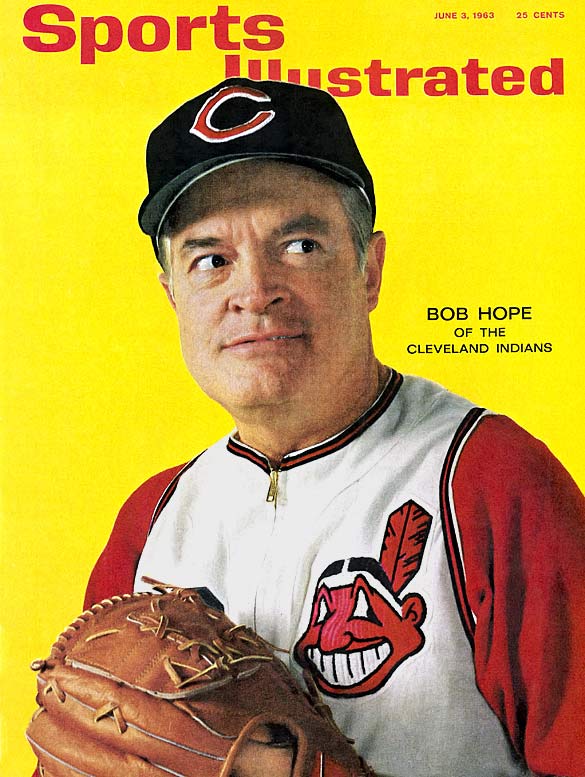 Oh, those poor Cleveland Indians fans of the mid 1950s! They had supported the home team to the tune of a then-respectable 1 million every season. But except for 1948 and 1954, they needed to be satisfied with finishing in second place behind the New York Yankees. Without a playoff system, they would average 95 wins per year, and mostly find themselves frozen out of postseason play.
Oh, those poor Cleveland Indians fans of the mid 1950s! They had supported the home team to the tune of a then-respectable 1 million every season. But except for 1948 and 1954, they needed to be satisfied with finishing in second place behind the New York Yankees. Without a playoff system, they would average 95 wins per year, and mostly find themselves frozen out of postseason play.
The Indians’ problem was not their pitching- over the eleven seasons from 1946 through 1956, they boasted eighteen 20-game winners. The Yankees had the second most, with seven.
Feller. Bearden. Lemon. Garcia. Wynn. Score. Manager Al Lopez, stoic and patient, wasn’t exactly Captain Hook- but he also had the premier bullpen in baseball in the form of Don Mossi and Ray Narleski. (Prior to inventing the tapping of the arm of the reliever he was summoning while walking to the mound, Lopez originally drew an imaginary “N” in the air for Narleski, and cupped his hands on the sides of his head for the large-eared Mossi).
Unfortunately, except for the World Series seasons, many of the position players on the Indians were nothing special. By 1956, left fielder Al Smith was a nice leadoff hitter with some pop. Vic Wertz was back to his power-hitting self after recovering from polio.
However, right fielder Rocky Colavito was just breaking into the league and was not quite yet a factor. Third baseman Al Rosen had been the American League Most Valuable Player in 1953, but various injuries reduced his effectiveness to the point that Cleveland fans began to boo him. Shortstop Chico Carrasquel and second baseman Bobby Avila were on the downside of their careers.
So this point in Tribe history post-dated their mid-20th Century run as pennant contenders. They were now at the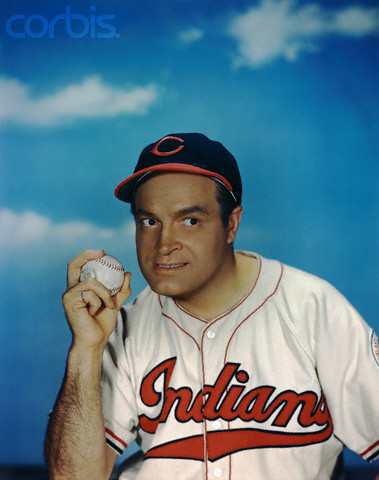 doorstep of the era of Frank “Trader” Lane, the man who would deal most of the promising prospects in their farm system. Roger Maris. Norm Cash. Early Wynn. He traded managers in 1960. And it was his trade of Colavito that many appear to believe caused a curse to be lowered on the Cleveland Indians franchise. (To us who don’t believe in sports curses, that trade at least defined over three decades of futility).
doorstep of the era of Frank “Trader” Lane, the man who would deal most of the promising prospects in their farm system. Roger Maris. Norm Cash. Early Wynn. He traded managers in 1960. And it was his trade of Colavito that many appear to believe caused a curse to be lowered on the Cleveland Indians franchise. (To us who don’t believe in sports curses, that trade at least defined over three decades of futility).
Both of these contrasting eras in Indians history were under the ‘watch’ of minority owner Bob Hope.
Bob Hope was a mega star. The wide arc of his entertainment career helped define the popularity of vaudeville, Broadway, movies, radio, and television. He was the friend of a long list of U.S. presidents, and hosted hundreds of USO shows that attracted A-list celebrities and boosted troop morale in various war zones through the years. (Black and white photos feature Hope with friend, movie partner, and Pirate fan Bing Crosby).
And Hope loved sports, from golf to boxing to his hometown Cleveland Indians.
Bob Hope had grown up on the near east side of Cleveland in the early 1900s. He said all the schools in Cleveland had drawn straws for him, and Fairmount Elementary lost so he enrolled there (he didn’t finish high school, although he cracked that he wrote so many test answers on his sleeve that his shirt graduated two years before he did). He was an entertainer from birth; his Charlie Chaplin imitation prompted neighbors to throw money down to him from their windows when he was ten years old. He took dancing lessons on Central Avenue as a young teenager, prior to some serious classes.
As a young child, Hope and three of his brothers sold 2-cent newspapers at various Cleveland street corners. One of his regular patrons was the wealthiest man in the world, John D. Rockefeller. The grumpy billionaire, whose house was beyond left field of nearby League Park, advised the boy to always have enough change, and not to trust anyone.
Hope also boxed. Eschewing his given name of Leslie (which attracted the nickname ‘Hope-Les’), he adopted the name Packy East. Hope thought that name sounded tough, and it was in reference to his friend, who went by the name of Packy West. He won his first two bouts, but got knocked out in his third and final fight after he landed his best punch (the last thing Hope remembered was a smile on the face of his opponent)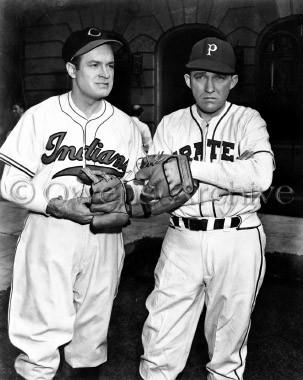 .
.
Hope was a young pool hustler in Cleveland, circa 1920. The Alhambra poolroom at East 105th and Euclid was where he became a child legend. All through his career, he variously displayed his skills, and talked smack with friendly rivals such as fellow comedian Jackie Gleason.
One of my favorite stories about Bob Hope’s youth is the one about how he used to hustle foot races. He and his friend (Whitey Jennings, the guy who was Packy West) would target the large Sunday picnics held in those days at Luna Park and Euclid Beach Park. These picnics would feature a 100-yard dash with prizes up to $15 for first place and $10 for second (real money, then). Since both races would be scheduled at the same time, Hope would call the company hosting the Euclid Beach picnic (like, say, a local steel company), and pretend he was with the Plain Dealer. He’d say he was interested in sending out a photographer. When informed of the time of their foot race, he’d express disappointment that it was at the same time as the Luna Park race. The time would get changed- the guests would eat first.
So Hope and his friend would ride the streetcar to Luna Park on Sunday, earning back the fare by singing and dancing on the way. They’d show up for the race, and jump out to an early start (they’d cheat). If they needed to, they’d bump their most serious rival- Hope early in the race and his friend halfway through. They would finish in the money, and head off to Euclid Beach and do it again.
Hope’s show business career moved in the direction of comedy, through vaudeville and Broadway, until he became a fixture in radio and movies in the 1940s.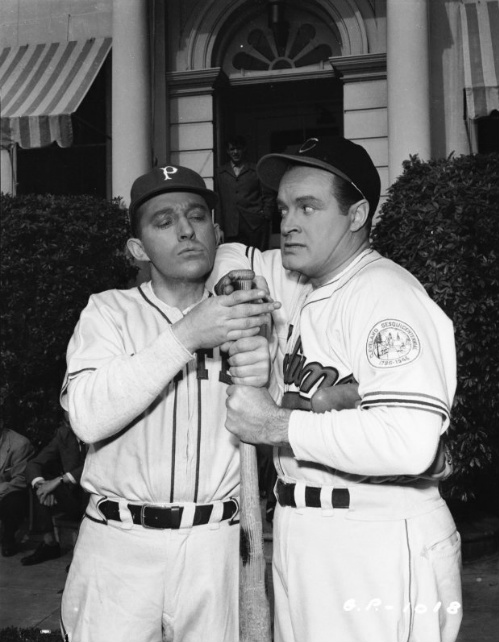
By 1946, returning World War II Marine Bill Veeck was about to purchase the Cleveland Indians ballclub. Alva Bradley was the main owner of the previous group, and Veeck noticed that many of the minority stakes were held by widows of previous owners. He purchased their shares, making his play under the nose of the surprised Bradley. With minutes to spare, and with a room full of reporters awaiting the expected announcement, Veeck’s financing came through and the Indians were his.
Veeck would revolutionize the game with signings of black ballplayers and a philosophy that centered on the common fan. (Stay tuned- more on Veeck in this corner in the weeks to come.) One of Veeck’s minority owners was Bob Hope.
Hope loved his Indians from the early days he’d spent peering at games through knotholes in the outfield fence at League Park. His favorite player was future Hall of Famer Tris Speaker, the Grey Eagle. The player-manager ruled center field and who also was a premier hitter in the years immediately preceding the career of Babe Ruth.
Veeck was forced to liquidate the Indians in 1949; he needed cash for his divorce settlement. Hope sold out as well, then bought back in the following year. He kept a small ownership share in the team for over forty years. He was a national ambassador for the team and his hometown.
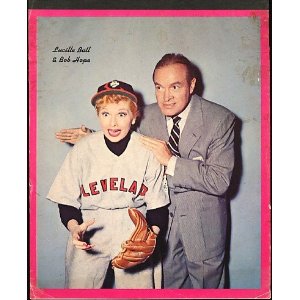 A nice example was his featured episode in the television series I Love Lucy. You may be savvy enough to find this online- it is Episode 154 of 181, from 1956. Lucy, her neighbors, and Little Ricky are attending an Indians game at Yankee Stadium. What do you know- Bob Hope emerges. Lucy decides this is a great opportunity to ask Hope to appear at Ricky’s new night club, the Club Babalu. Lucy dresses up as a hot dog vendor and approaches Hope. She distracts him. Unfortunately, a foul ball hits Hope in the head. Ricky shows up and finds Hope in the Indians locker room, nursing his head. Lucy appears again, dressed as a Cleveland Indians player. Oops! She sees Ricky and tries to escape. He does not let her. Ricky and Hope talk about performing something for the show, and Lucy wants to join in. Of course, Ricky says no. Hope insists on her joining them for a couple songs. (Desi Arnaz- Ricky- had been the orchestra leader on Hope’s radio show back in the late 1940s.)
A nice example was his featured episode in the television series I Love Lucy. You may be savvy enough to find this online- it is Episode 154 of 181, from 1956. Lucy, her neighbors, and Little Ricky are attending an Indians game at Yankee Stadium. What do you know- Bob Hope emerges. Lucy decides this is a great opportunity to ask Hope to appear at Ricky’s new night club, the Club Babalu. Lucy dresses up as a hot dog vendor and approaches Hope. She distracts him. Unfortunately, a foul ball hits Hope in the head. Ricky shows up and finds Hope in the Indians locker room, nursing his head. Lucy appears again, dressed as a Cleveland Indians player. Oops! She sees Ricky and tries to escape. He does not let her. Ricky and Hope talk about performing something for the show, and Lucy wants to join in. Of course, Ricky says no. Hope insists on her joining them for a couple songs. (Desi Arnaz- Ricky- had been the orchestra leader on Hope’s radio show back in the late 1940s.)
Bob Hope also owned a small interest in the Los Angeles Rams, and actually put forth a bid to purchase the Washington Senators (now the Texas Rangers) in 1969. One of his countless charity endeavors led to him getting teamed up with Cincinnatian Bill DeWitt (father of current St. Louis Cardinals owner) as part of an ownership group. DeWitt would have owned 10%, comedian Johnny Carson 10% as well, and previous half-owner of the team James Lemon 10%. Hope would own 70% of the ballclub. He procrastinated, allowing two deadlines to pass, and Bob Short purchased the team as majority owner.
Hope seldom passed up a chance to crack a joke. (He said that there are two baseball clubs in Los Angeles, the Angels and the Dodgers. By the way people drive their cars out there, you just naturally become a follower of one club or the other.) But on a notably serious note, he was clear on the Indians of the mid-1960s. They weren’t drawing many fans, but the team didn’t need to move. It needed to win some games and give people a reason to show up.
Bob Hope lived to be 100 years old. He passed away in 2003. Indians fans recall his appearance at the old stadium’s final game, in 1993. He was warmly received by the crowd, who’d been treated to a day of nostalgia (Mel Harder, the pitcher in the stadium’s first game 60 years prior, threw the final pitch of the day). Hope sang a specially tailored version of his signature song, “Thanks for the Memories”. He’d remained a true Clevelander, no matter where in the world his life led him. Just like us.
Thank you for reading.
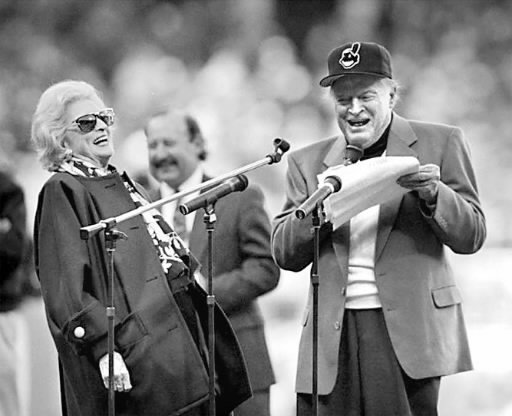
- NBA Announces 2013-2014 Schedule
- Browns Ink Sharknado
- Sharknado A No-Show For Rookie Camp
- Trent Richardson Out Until Training Camp
- Browns Sign Brandon Jackson
- Carrasco Suspended Eight Games
- Browns Add to Wide Receiver Depth with David Nelson
- Browns Need to Learn from Past Draft Mistakes
- Browns Release Chris Gocong and Usama Young
- Browns Missing on Grimes Disappointing, But Not The End
The TCF Forums
- Chris Grant's first 3 drafts
Kingpin74 (Tuesday, January 21 2014 10:13 AM) - The 2014 Offseason Thread
googleeph2 (Tuesday, January 21 2014 9:36 AM) - 2015 Recruiting
furls (Tuesday, January 21 2014 6:57 AM) - Mike Brown
YahooFanChicago (Monday, January 20 2014 11:15 PM) - Movies coming out
HoodooMan (Monday, January 20 2014 9:34 PM) - 2014 Hoops Hockey Hijinx
jpd1224 (Monday, January 20 2014 4:44 PM) - 2014 Recruiting
jclvd_23 (Monday, January 20 2014 2:26 PM) - Wish List - #4 Pick
Hikohadon (Monday, January 20 2014 1:26 PM) - Official- Browns Coach Search/Rumors
OldDawg (Sunday, January 19 2014 6:48 PM) - #1 overall pick Anthony Bennett
TouchEmAllTime (Sunday, January 19 2014 1:28 PM)



